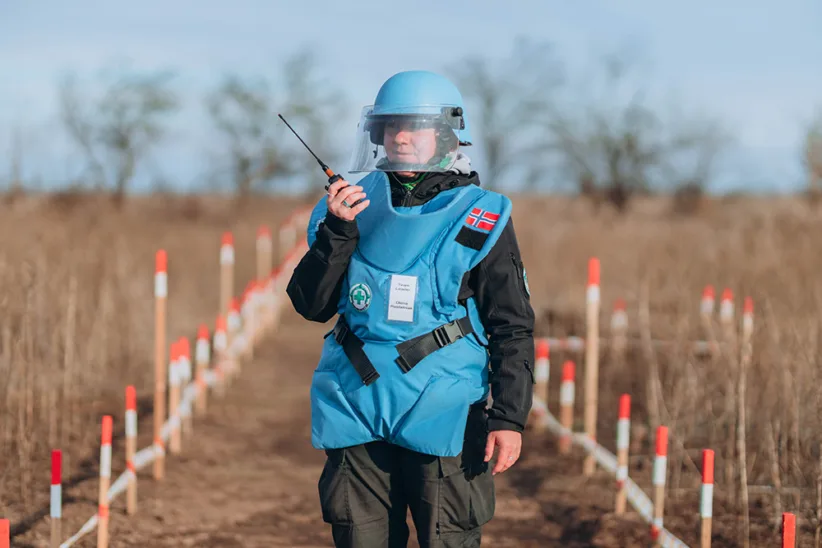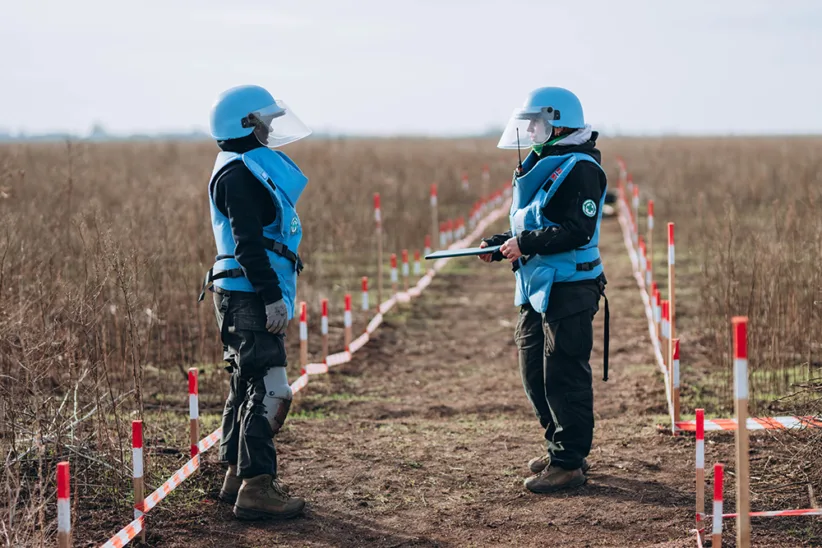The world according to a Ukrainian female deminer
Olena Postelniak is a deminer team leader and works for Norwegian People`s Aid (NPA) in Ukraine. She works in the minefields in the southern Oblast province of Mykolaiv in the south of Ukraine. The explosives here are leftovers from the Russian invasion after they were fought back by the Ukrainian defense forces.

Could you tell me something about your job as a demining team leader?
“The essence of my job is to lead the deminers who are under my supervision. I also have to communicate with operational management on various work-related issues, the progress of clearance tasks, and reporting,” says Olena. “I work directly on the minefield; I control the work processes and monitor the work of my deminers, most of my time is spent communicating with and managing people, she continues. “
Olena says that part of her role is also to review clearance tasks and decide how to deploy the team and approach the work.
Adrenaline
“As for the specifics of a deminer’s job, which I used to do before becoming a team leader, I think it’s quite an interesting job as well. It has a certain level of constant adrenaline. I mean, you must be very attentive and meticulous in order not to miss anything, because your life directly depends on it,” says Olena.
Where do you get the courage to do such a risky job?
“As for the courage to go into this field... I have always been known among my family for making unusual decisions. And when I decided to apply for this position, I was mainly just curious. I was a bit scared, but I realized that many people do this job. And someone needs to do it anyway, so why not? And it follows where I get my courage – I get it from rationality. That is; I analyze all the processes and procedures we have, and all the rules and instructions we work by. During the deminer training, we studied a lot of different information about explosive ordnance, about different types, how they function, and what they look like. This training gave me an understanding that if you treat the work with caution if you are attentive, calm, without sudden movements or actions, and if you follow the prescribed procedures, then this will maximize your safety.”
Ukraine is an important agricultural country – do you have many demining missions on cultivated/agricultural land?
“As far as I know, most of our sites are on agricultural land,” says Olena. “We can say that this is one of our focus areas.”
How does the war and possibly demining damage the soil?
“Due to the full-scale war, the military actions, shelling, and bombing – everything brings pollution with harmful substances, chemicals, metals, and so on, and any explosive is a substance in itself that is harmful to the environment, even if it explodes, there are still some remnants of it, some remnants of metal contamination from this detonation, just remnants of explosives, ash.”
Time
How long does it take to remove the mines or cluster bombs?
“It’s a rather long process, which depends on many factors, including the weather, the quality of the soil; whether it is possible to work with detectors on this soil or not, and the availability of special machinery. The deployment of mine detection dogs and demining machines speed up the process greatly, but it still takes a lot of time.”

Marijn van Broekhoven is the NPA Ukraine Programme Coordinator in Ukraine.
What happens after the clearing of the mines and cluster bombs? Can the soil be cultivated again – and how long it will it take before it is restored?
“Norwegian People`s Aid conducts internal quality control over cleared areas to ensure all the work is conducted safely, consistently, and reliably. Once a clearance task is fully completed it will be reported to the relevant Ukrainian authorities. They will conduct additional quality control before formally releasing and returning the land to the landowners and/or community. This means that when the land is formally released it can be used immediately, and with confidence, for agriculture or other purposes,” Marjin answers.
Close to the front
Are the deminers particularly vulnerable to attacks from the Russian side?
“Norwegian People`s Aid does not operate within 30 kilometers from the active frontline, in case there are any movements of the battle lines affecting this safety distance then we will move our teams accordingly,” says Marjin
“Furthermore, Norwegian People`s Aid has dedicated security staff to carry out security assessments and monitor changes in the context to inform our decision-making processes. If there are any indications that our staff might be at risk then we immediately withdraw the affected teams from the field, for instance, if artillery systems are activated near our operational sites.”
Do you have the capacity to clear all the areas in Ukraine that are hit by mines and cluster bombs?
“The scale of the current explosive ordnance contamination in Ukraine makes it impossible for any operator to deal with the issue alone. The massive problem can only be addressed through a coordinated effort involving different actors, including national and international NGOs, commercial operators, and Ukrainian government agencies. It should also be noted that large parts of Ukraine are currently under Russian occupation and not accessible to mine action operators.”
